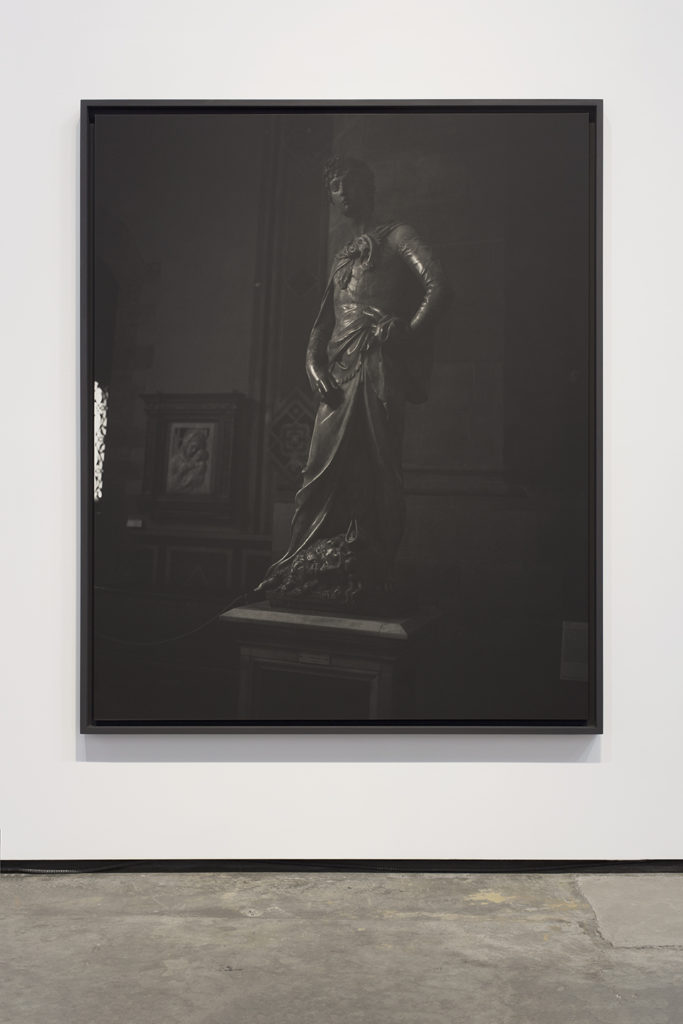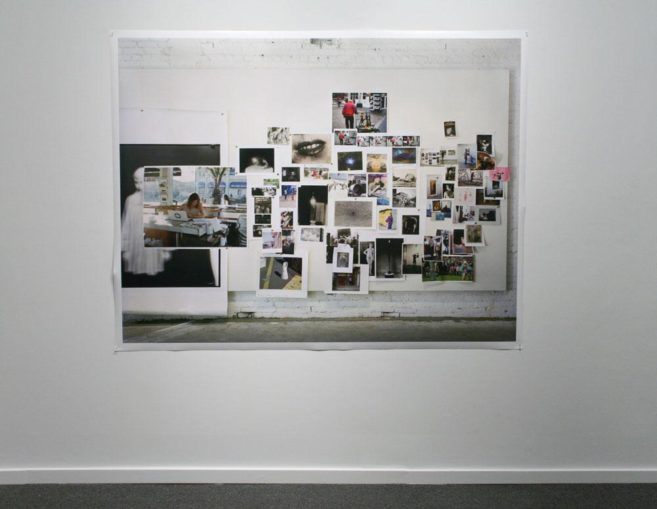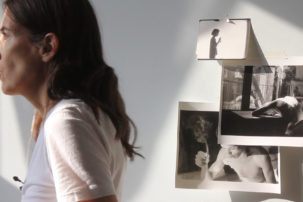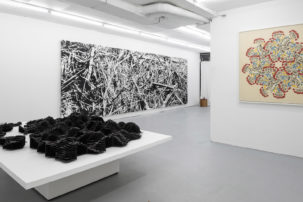Stephen Waddell’s latest solo exhibition, “Visible Light,” aims to create a conversation between the aesthetic function of light and light as an essential metaphor within the archetypes of art and literature. Sunflowers (2018) is a large piece in glossy hyper-coloured blues and yellows of a residential street where a woman is seen watering sunflowers at dusk. The image is installed next to David (2017), a silver-gelatin photograph of a classical sculpture of David, printed to eliminate any shadow, thus rendering the sculpture flat. Waddell suggests a connection-by-comparison here: the contrast of sculpted light in one image playing against the neutralized depth of the other, questioning the perceptual boundaries of form, material and technique. For the viewer, links between the subjects presented remain confounding—any deeper meaning behind these intriguing technical exercises is obscured by a visual symbolism of biblical proportions.
Hive Burner (2017) pulls its reference from Cranach’s The Golden Age, a classical painting inspired by the Greek poet Hesoid’s “Works and Day.” Waddell’s sparklingly sharp composition is set among the pastoral ruins of a Vancouver saw mill. You can almost hear the autumnal leaves crunching beneath a red-caped woman’s foot, while a tanker ship looms in the background. The utopia of eternal peace and plenty that Cranach’s frolicking figures evoke is now a paradise lost in Waddell’s image.
On the wall opposite to Hive Burner is Expulsion (2018), where a modern-day Adam and Eve recreate their explosion from the Garden of Eden. Adam is dressed in grim grey pants; Eve wears a t-shirt and shorts. They seem to flee from inside a circular ruin, similar to the one depicted in Hive Burner. In both photos we see the questioning of the light of knowledge—Adam and Eve’s entrance into the world, the broken utopia of Cranach—reflected in the light of the camera.
Waddell is a masterful photographer, and taken individually, the six works in “Visible Light” present a compelling technical back-and-forth between photography, painting and the aesthetics of light. At the same time, he challenges the viewer to connect classical metaphors associated with light—the Garden of Eden, the Enlightenment, the Renaissance, Plato’s Allegory of the Cave, Cranach’s utopia—to make sense of a subtle play of meaning across the images. Yet that conversation among the works remains elusive. To employ these symbolically loaded references and not consistently engage with their contemporary relevance is to leave a portion of the work in the dark.

Stephen Waddell, David, 2017. Silver gelatin print, 1.71 x 1.37 m. Courtesy the artist/Monte Clark Gallery.

Stephen Waddell, Sunflowers, 2018. Archival pigment print, 1.52 x 2.36 m. Courtesy the artist/Monte Clark Gallery.

From left: Stephen Waddell, David, 2017. Silver gelatin print, 1.71 x 1.37 m; and Sunflowers, 2018. Archival pigment print, 1.52 x 2.36 m. Courtesy the artist/Monte Clark Gallery.

Stephen Waddell, Two Women, 2014. Silver gelatin print, 1.24 m x 106.6 cm. Courtesy the artist/Monte Clark Gallery.

From left: Stephen Waddell, Two Women, 2014. Silver gelatin print, 1.24 m x 106.6 cm; and Hive Burner, 2017. Archival pigment print, 1.57 x 2.38 m. Courtesy the artist/Monte Clark Gallery.

Stephen Waddell, Expulsion, 2018. Archival pigment print, 1.49 x 1.95 m. Courtesy the artist/Monte Clark Gallery.

From left: Stephen Waddell, Expulsion, 2018. Archival pigment print, 1.49 x 1.95 m; and Kammerspiele, 2016. Silver gelatin print, 1.25 m x 99.6 cm. Courtesy the artist/Monte Clark Gallery.

Stephen Waddell, Kammerspiele, 2016. Silver gelatin print, 1.25 m x 99.6 cm. Courtesy the artist/Monte Clark Gallery.







